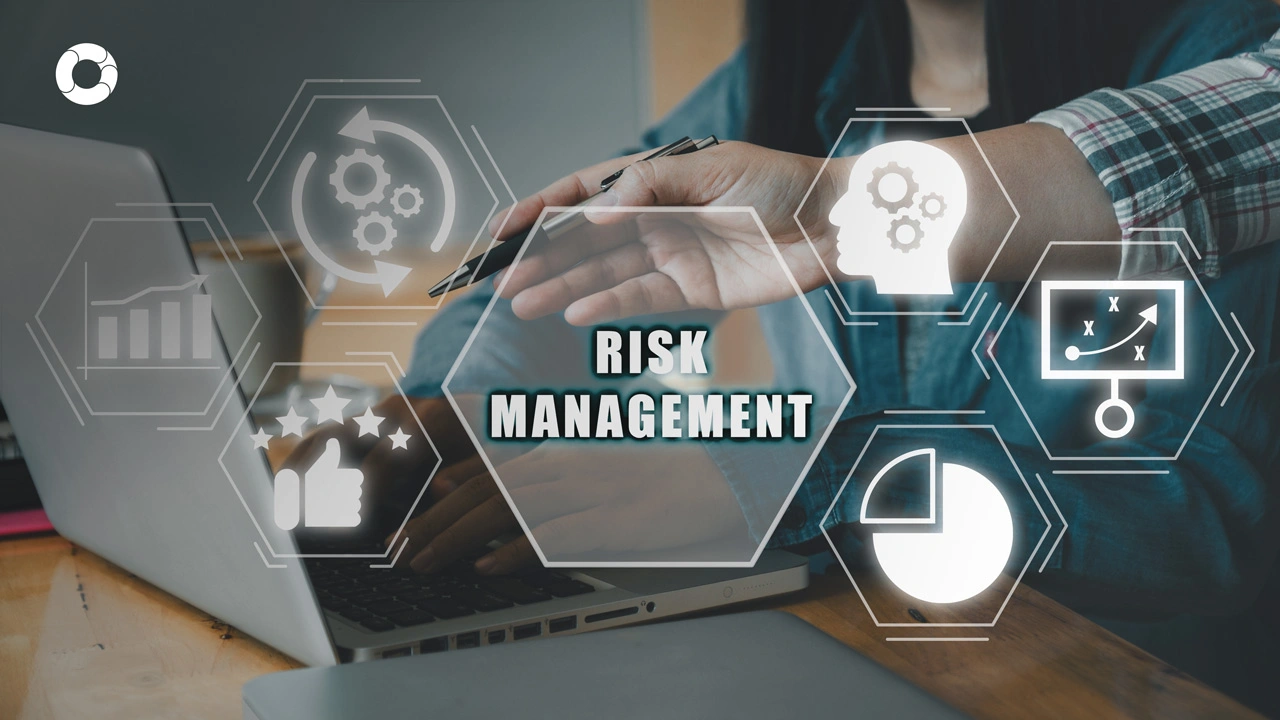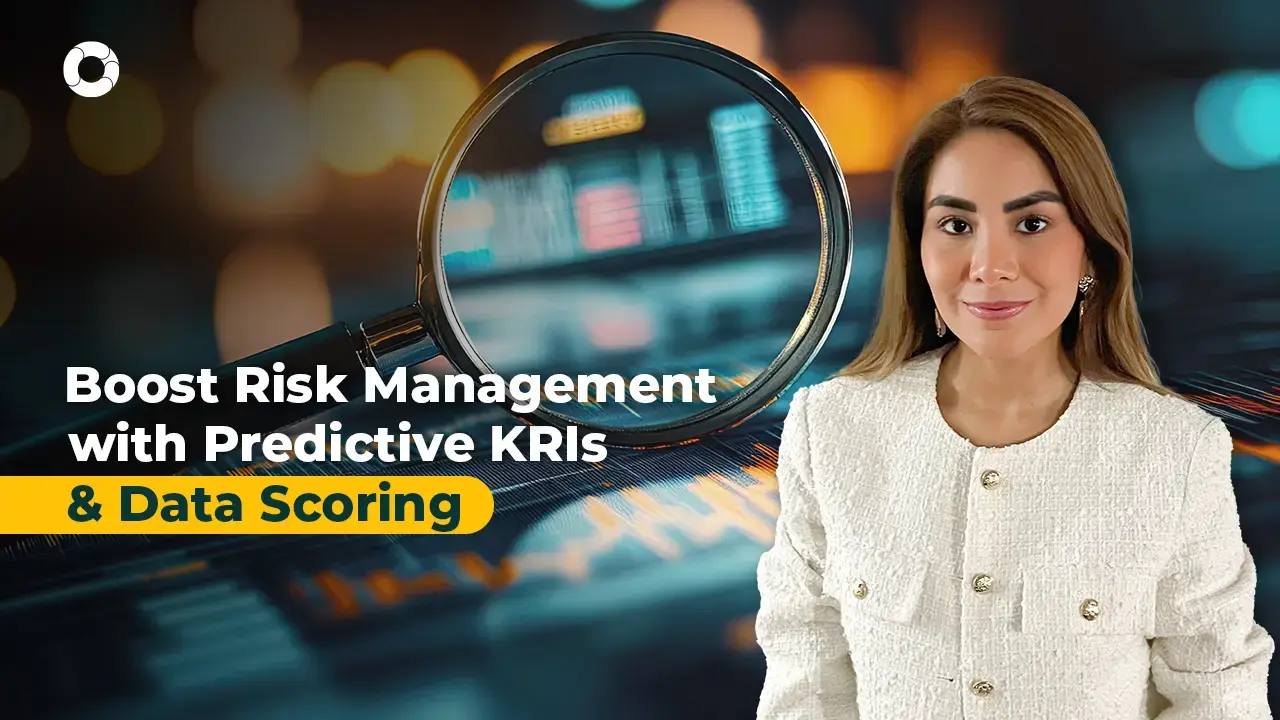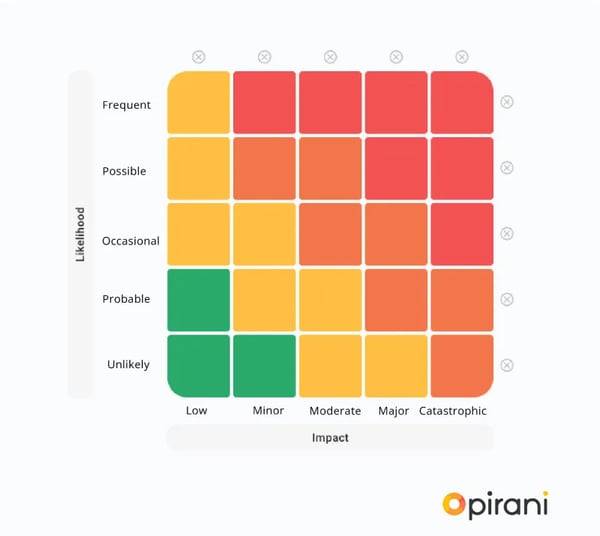How to make a risk matrix for your company
The risk matrix is a key tool for risk management in companies since it allows for visualizing, quantifying, controlling, transferring, or mitigating risks and, most importantly, making strategic decisions. For risk management to be effective and contribute to the achievement of business objectives, it is essential to have this tool in place from the outset.
In this article, we will explain what the risk matrix is, how to build it step by step, and we will delve into two of its essential elements: frequency and impact. You will also learn how these factors allow you to determine the level of inherent risk and place it within the matrix.
In addition, we will explore how this management and control tool allows you to analyze and monitor key aspects such as risk criteria, risk appetite, and risk tolerance. Finally, Felipe Perdomo, a specialist in risk management and insurance, will share his vision on the importance of frequency and impact in the use of the risk matrix.
What is a risk matrix?
The risk matrix is a tool that helps to identify, evaluate and prioritize the risks that may occur in the operation, implementation of services or any other process that may affect the organization's objectives.
Having this matrix also helps managers and personnel in charge to make quicker decisions on how to act to address the risks that are most likely to occur and impact the operation.
This tool is usually represented as a probability and impact grid, where each cell combines different levels of how likely it is to occur (probability) and what the impact would be (impact), categorizing risks as low, moderate, and high.
What is the purpose of having a risk matrix?
The main purpose of the risk matrix is to provide a visual and structured way to identify, evaluate, and prioritize the risks an organization faces. By having this visual tool, companies can:
Identify risks: By detecting possible threats that could arise in various processes of the organization, influenced by internal or external factors.
Evaluate probability and impact: By analyzing how likely it is that certain events will occur and what impact they would have on operations or business strategy.
Prioritize risks: With the risk matrix, you can determine which are the most significant risks to take immediate action, ensuring that resources are allocated to what really matters.
Address risks: Helps implement strategies to reduce the likelihood of risks occurring or minimize their impact if they do occur.
By having a clear view of the risks, the matrix facilitates key decisions for the organization and helps to establish what the planning will be to protect the company against possible unforeseen events.
When should the risk matrix be reviewed and updated?
The risk matrix should be reviewed regularly to ensure that it is aligned with the current risks facing the organization. This review is especially important when significant changes occur in the environment, such as in the industry, legislation, technology, or internal operations. In addition, it is advisable to conduct an annual review as part of the ongoing risk management process and to update it whenever a major new risk is identified, such as changes in internal processes, the entry of a competitor, or the emergence of new regulatory or technological risks.
It is important to remember that a risk matrix is not a static tool, but a dynamic and constantly evolving one, since risks are constantly changing. As Juan Carlos Medina, a recognized expert in risk prevention, points out, “In risks everything is cyclical, you have to be constantly monitoring them because they never end, they just keep changing.” It is therefore essential that the matrix is regularly updated and reviewed, ensuring that risks are identified and managed in real-time, allowing organizations to adapt quickly and make informed decisions in the face of a changing environment.
What are the types of risks?
To identify and manage risks in a matrix, it is essential to know the types of risks that exist, as these can arise from various areas, such as internal operations, the financial environment, technological factors, or even the company's reputation. Identifying the different types of risks allows you to make informed decisions, minimize negative impacts, and create effective strategies to mitigate potential risks.
Here we tell you what are the main types and examples to understand them simply:
- Operational risks
Operational risks arise from the company's internal processes and are closely related to the management of daily operations. These risks may include production failures, supply chain deficiencies, human error, technology failures, or customer service problems. Proper identification and management of these risks is crucial to ensure operational efficiency and avoid negative impacts on productivity and customer satisfaction.
Example: An electronics distribution company relies on inventory management software. Imagine if the system fails and does not update stock correctly, there could be stock-outs of popular products, affecting sales and customer satisfaction. This would be a clear example of technology-related operational risk.
- Financial risks
Financial risks are related to the economic stability of the company and how it manages its financial resources. They may arise from variations in the financial markets, liquidity difficulties, customer delinquencies, or changes in operating costs.
Example: A bank has a large portfolio of variable-rate loans. Due to an unexpected increase in market interest rates, the bank sees the cost of the loans it offers increase considerably. This creates a financial risk because if customers are unable to pay their more expensive debts, the bank will face a higher level of defaults, which will affect its cash flow and could compromise its financial stability.
-
Technological Risks
Technological risks are associated with the technology used by the company, including failures in IT systems, security breaches, outdated software, or the obsolescence of technological infrastructures. These risks can affect operational efficiency, the protection of confidential data, service continuity, and ultimately, the company's reputation.
Example:
An e-commerce business relies entirely on its website to make sales. If the online payment system suffers a security vulnerability that allows a cyberattack, sensitive customer data—such as credit card numbers—could be stolen. Additionally, the website may be down for several hours, affecting sales and damaging customer trust.
-
Strategic Risks
Strategic risks are related to the long-term decisions made by the company, such as expansion plans, changes in the business model, or new investments. These risks may arise if decisions do not align with market trends, competition, or the company’s internal capabilities. Strategic risks can have a significant impact on the overall objectives of the organization, affecting long-term viability, growth, or profitability if not properly managed.
Example:
A restaurant chain decides to expand internationally without conducting proper market research in the countries it plans to enter. Due to cultural differences and low demand for their products in these markets, the expansion fails, and the company loses a substantial amount of money.
-
Reputational Risks
Reputational risks affect the public image of the company. Poor brand management, scandals, or a public relations crisis can damage the trust that customers, partners, employees, and the public have in the organization. These risks can impact customer loyalty, relationships with investors and other stakeholders, and even affect financial performance. Damage to reputation can persist for years and is difficult to reverse, making proactive reputation management essential.
Example:
A famous clothing brand is accused of using child labor in its supply chain. Although the company denies the allegations, the media, and social networks amplify the scandal, and many consumers stop purchasing their products. As a result of this damage to its image, the brand loses customers, and its reputation is seriously affected.
Download this ebook to learn in-depth about reputational risk and how to manage it effectively.
-
Legal and Regulatory Risks
Legal and regulatory risks arise from non-compliance with laws or regulations that affect the company, either by action or omission. These risks may occur due to changes in local, national, or international laws and can result in fines, sanctions, costly litigation, or operational losses. Additionally, non-compliance may impact the company's reputation and its ability to operate in certain markets or sectors. Adapting to current regulations is key to avoiding these risks.
Example:
A technology company operating in multiple countries fails to comply with the European Union’s data protection regulations, such as the General Data Protection Regulation (GDPR). As a result, the company faces a multimillion-dollar fine and loses user trust.
We recommend reading the article we have on managing legal risk in organizations to expand your knowledge on this topic.
-
ESG Risks (Environmental, Social, and Governance)
ESG risks are those related to environmental, social, and governance factors that may impact a company’s performance. These risks are becoming increasingly relevant due to growing concerns about sustainability, social equity, and responsible business practices.
Example:
A mining company that fails to implement measures to mitigate its environmental impact, such as deforestation or water pollution, may face government sanctions, community protests, and a decline in brand value. Additionally, if it lacks clear governance policies—such as anti-corruption measures or transparency in practices—it may lose investor confidence.
Download this ebook to learn in-depth about ESG risks.
How to Create a Risk Matrix
Before creating a risk matrix, it’s important to define a reference framework or methodology for risk management, such as ISO 31000 or the COSO framework.
Once you’ve defined this and identified the risks within your company, keep in mind the following steps to create and implement your risk matrix:
1. Prioritize the identified risks
It is essential to identify the risks present across the different processes of the company, considering their scope and context. Remember, risk detection should not be a task carried out by just one person. It is a joint effort between the risk manager and the various departments of the organization, as they are the ones who best understand the risks they face daily and can identify which ones are the most critical.
At Pirani, we have created an Excel template that allows you to build your risk matrix step by step. Download it now and start creating your risk matrix easily and in a structured way.
Keep in mind that the risks you identify and prioritize must be aligned with your industry, your environment, and your company’s processes. To help you perform this analysis effectively, download our guide to conducting a risk analysis.
2. Assess the Probability and Impact of Risks
This evaluation allows you to prioritize risks according to their likelihood of occurrence and potential effects, facilitating informed decision-making.
To perform this analysis, two main factors must be considered: probability and impact.
The combination of these two factors determines the priority of each risk. For instance, a risk with high probability and high impact must be managed urgently, while one with low probability and low impact can be monitored less frequently.
To do this, consider these classifications:
| Frequency | Impact |
| 1. Unlikely | 1. Negligible |
| 2. Possible | 2. Minor |
| 3. Occasional | 3. Moderate |
| 4. Probable | 4. Major |
| 5. Frequent | 5. Catastrophic |
Let’s take an example: A business dedicated to the manufacturing and commercialization of chairs, desks, and tables for offices and social spaces identifies one of its main risks as the potential damage to one or several of its machines used for cutting wood and other materials.
This risk is classified as probable in frequency (4) and catastrophic in impact (5), because if the damage occurs—whether due to excessive use of the equipment, improper handling, a sudden power outage, or any other cause—the personnel operating the machine will have to stop working until a solution is found.
This will cause delays throughout the manufacturing and assembly process of the furniture. Additionally, if the damage is not resolved as quickly as possible, it will negatively impact the delivery and commercialization of the products.
Just like with this risk—which is considered inherent (as it has both a frequency and an impact)—this same company may face other risks such as workplace accidents, failures in public service supply, cyberattacks on its IT systems, and so on. For all of these, both frequency and impact must be defined.
Regardless of how many or which specific risks there are, the key is to include them all in the risk matrix and evaluate them correctly to understand which ones are the most critical for operations and business continuity. This way, if they materialize, appropriate controls can be implemented to help mitigate them.
It’s important to note that when inherent risks are managed by applying controls, they are then considered residual risks.
3. Graphically Represent the Risks You Have Evaluated
Once you’ve assessed the probability and impact of the risks in your company, it’s crucial to represent them graphically to facilitate visualization and prioritization. A risk map is a powerful visual tool that allows you to quickly see which risks are the most critical and which require immediate attention.
Common color codes in a risk map:
-
Green: Represents low-impact, low-probability risks. Although they do not require urgent actions, it is important to monitor them regularly to prevent them from turning into significant threats.
-
Yellow: Indicates moderate risks. These have a moderate likelihood of occurring and an impact that, while not critical, could still affect operations if not managed properly.
-
Orange: Refers to risks with high impact but low probability. Although less frequent, if they materialize, the impact will be considerable, so they must be closely monitored.
-
Red: These are critical risks. They have a high probability of occurring and, if they happen, could have a devastating impact on the company. Immediate action and an urgent mitigation plan are required.
Why Use a Risk Map?
Using a color-coded risk map makes it easier to quickly identify critical risks and helps prioritize corrective or preventive actions. This visual representation also improves communication among teams, ensuring that everyone is aware of the risks and informed decisions are made.
For a complete guide on creating risk maps, check out our article: Heat Map: Visualize Your Risks.
Also, take a look at: Examples of Risk Matrices for Major Industries.
Now that you know this, we invite you to put it into practice in your organization, and a simple way to do it is through technological solutions such as the Pirani management software, a tool designed so that you can make the risk matrix yourself, without depending on anyone, and in just a few minutes, and also so that you can easily record processes, risks, and controls.
Recommendations After Creating a Risk Matrix
Remember, creating a risk matrix is only the first step in an ongoing risk management process. Here are some key recommendations to help you optimize the results of your risk matrix:
-
Continuously Monitor Identified Risks
After creating your risk matrix, it’s essential to establish a continuous monitoring process. How often should you do it? This depends on each organization, but our recommendation is to review the risk matrix at least once every quarter. This way, you can keep it updated and aligned with your organization's dynamic environment.
-
Prioritize Critical Risks
Use the risk map to identify those risks with high probability and significant impact. These must be managed urgently. Implement specific action plans to mitigate these risks and assign clear responsibilities for each action.
-
Implement Controls
The risks identified in your matrix should be accompanied by mitigation controls. After conducting the risk analysis, make sure there are preventive, detective, and corrective mechanisms in place to reduce the likelihood or impact of the risks. Regularly review the effectiveness of these controls and adjust them as needed to improve their effectiveness.
-
Evaluate Residual Risk
After applying controls, evaluate the residual risk—the risk that remains after implementing mitigation measures. This risk should be acceptable for the company, but it’s important to continue monitoring it to ensure it does not escalate to uncontrollable levels.
-
Document and Communicate Risk Matrix Results
It is necessary to properly document all identified risks, the evaluations carried out, and the actions taken to maintain an organized risk management process. Additionally, make sure to communicate the results of the risk analysis and the measures adopted to the managers of each area within the company. This practice not only facilitates interdepartmental collaboration but also fosters a risk management culture throughout the organization, improving decision-making and risk mitigation more effectively.
Examples of Risk Matrices for Major Industries
To move into practice, we’ll review four examples in sectors that have high relevance for risk management:
the financial sector, responsible for all activities related to monetary flows such as loans, mortgages, insurance, credit, pension funds, and more.
The retail sector, includes all establishments that sell products individually to the final consumer, such as online commerce or supermarkets.
The food sector encompasses beverages and all companies involved in the production of raw food materials. Don’t forget that this also includes those who package and distribute these products.
In the mining sector, all activities involved in the extraction and processing of natural resources are included, and regulators and trade associations oversee these activities.
1. Risk Matrix in the Financial Sector
From internal fraud to market fluctuations, risks in the financial sector can be numerous. Implementing a risk matrix for this sector is essential due to the complexity of the environment they face. It allows resources and efforts to be prioritized based on the impact and likelihood of identified risks. This leads to better capital allocation and strategic planning, reducing the possibility of significant losses and improving the ability to respond to adverse events.
Here’s how to apply a risk matrix in the financial sector:
Risk 1: Internal Fraud
- Probability: Medium
- Impact: High
- Mitigation: Internal audits, implementation of monitoring software
Risk 2: Market Fluctuations
- Probability: High
- Impact: High
- Mitigation: Diversification of investments, continuous market analysis
Risk 3: Technological Failures
- Probability: Low
- Impact: High
- Mitigation: Regular software updates, daily backups

2. Risk Matrix in the Retail Sector
The retail sector faces risks related to supply chain management and shifts in consumer trends, ranging from operational risks to risks related to fraud and cybersecurity. This is particularly relevant in the digital era, where transactions occur online and customer information management can be exposed to theft.
Implementing a risk matrix helps identify vulnerabilities in payment systems, protection of personal data, and IT security, enabling appropriate controls to address cyber threats.
Here’s how to apply a risk matrix in the retail sector:
Risk 1: Supply Chain Disruption
- Probability: Medium
- Impact: High
- Mitigation: Strategic plan to maintain strong supplier relationships, emergency inventories
Risk 2: Changes in Consumer Trends
- Probability: High
- Impact: Medium
- Mitigation: Market analysis, flexibility in product offerings
Risk 3: Theft and Losses
- Probability: High
- Impact: High
- Mitigation: Advanced security systems, staff training

3. Risk Matrix in the Food Sector
The food sector faces risks such as product contamination, disruptions in ingredient supply, regulatory changes, and fluctuations in input prices. A risk matrix allows food companies to anticipate and manage these risks in a timely manner, ensuring operational continuity and minimizing the impact on production and distribution capacity.
Another important aspect is reputation and corporate social responsibility, avoiding incidents like contaminated product recalls or accusations of unfair labor practices.
Here’s an example for the food sector:
Risk 1: Product Contamination
- Probability: Medium
- Impact: High
- Mitigation: Implementation of HACCP systems, rigorous quality controls
Risk 2: Ingredient Supply Disruptions
- Probability: Low
- Impact: High
- Mitigation: Contracts with alternative suppliers, safety stock inventories
Risk 3: Regulatory Changes
- Probability: Medium
- Impact: Medium
- Mitigation: Constant monitoring of legislation, rapid adaptation to new regulations

4. Risk Matrix in the Mining Sector
The nature of mining inherently involves significant risks both to worker safety and the environment. Issues such as occupational health, accidents within the mines, rock falls, and constant exposure to chemicals are part of the risks to be mitigated in a risk matrix for this sector.
Environmental risks also play a key role, including water and soil contamination, deforestation, impacts on biodiversity, and ecosystem disturbances. Through the implementation of a risk matrix, adequate mitigation measures can be enforced to comply with current environmental regulations, ensuring sustainability throughout all activities.
Here’s an example for the mining sector:
Risk 1: Accidents Within Mines
- Probability: Medium
- Impact: High
- Mitigation: Continuous occupational safety training, mandatory use of PPE (personal protective equipment), strict supervision
Risk 2: Water and Soil Contamination
- Probability: Medium
- Impact: High
- Mitigation: Implementation of environmental management systems, constant monitoring of discharges, and compliance with international standards
Risk 3: Regulatory Changes
- Probability: Medium
- Impact: Medium
- Mitigation: Constant monitoring of legislation, rapid adaptation to new regulations

What Challenges Might You Face When Implementing a Risk Matrix?
Implementing a risk matrix may seem like a daunting task, but it is essential to ensure effective management that minimizes risks and their impact on your company’s processes. Aligning the efforts of the entire team is key so that employees understand and adopt the benefits of managing risks properly. While correctly assessing the probability and impact of identified risks can be challenging, the long-term benefits—such as fewer incidents and better decision-making—are significant.
Here are the most common challenges when implementing a risk matrix:
1. Resistance to Change
Staff may be reluctant to modify their habits or adopt new practices. This is common in companies where processes are already well-established, making it difficult to accept new tools or methodologies.
One solution we recommend is fostering effective communication, training your teams, and highlighting the tangible benefits of the risk matrix, such as accident prevention and improved efficiency.
2. Lack of Resources
Budget limitations or a lack of specialized personnel can hinder the implementation of a complete risk matrix.
To address this challenge, prioritize the most critical risks, leverage low-cost management tools, and train internal staff to optimize existing resources.
3. Complexity in Evaluation
Identifying and assessing the probability and impact of risks can be complicated due to a lack of data or subjectivity in analysis.
Remember to use recognized methodologies such as ISO 31000, involve multidisciplinary experts, and rely on technology that facilitates risk analysis.
What Is Frequency and What Are Its Scales?
Frequency refers to the likelihood of a risk occurring. In a risk matrix, this probability can be determined using qualitative and quantitative value scales. These can have three, four, five, or more levels (defined by the methodology each company chooses).
Generally, the most commonly used scales have five values, for example:
- Unlikely: The probability of the risk materializing is very low, almost negligible.
- Possible: The probability is low but possible.
- Occasional: The risk can materialize at any moment.
- Probable: The likelihood of the risk occurring is high and often happens.
- Frequent: The probability of occurrence is very high.
This scale can also be expressed in percentages or with different names. For instance:
| Percentage | Qualitative value |
| 0 - 20% | Very low |
| 20,1 - 40% | Low |
| 40,1 - 60% | Medium |
| 60,1 - 80% | High |
| 80,1 - 100% | Very high |
This system of scales is applicable to any organization. It is recommended to use the scale that best fits the company’s chosen methodology.
What Is Impact and What Are Its Scales?
Impact refers to the set of consequences caused by the materialization of a risk, meaning the effect it would have on the company. These can be economic, legal, and reputational, among others.
As with frequency, the impact is determined using scales, which is a five-level system might be:
- Insignificant: The impact poses no problem to the organization.
- Minor: The risk's impact on the company’s objectives is minimal.
- Moderate: The risk could cause a temporary loss.
- Major: It generates significant delays affecting objective achievement.
- Catastrophic: It may halt the company’s operations or even result in permanent closure.
These values can also be labeled differently, such as Very Low, Low, Medium, High, and Very High, depending on each organization's methodology and objectives.
Placement of Frequency and Impact in the Risk Matrix
The risk matrix, also known as the risk map, is composed of a vertical (Y) axis and a horizontal (X) axis. Matrices can be 3x3, 4x4, or 5x5 (the most common).
On the Y-axis, you place the frequency values, and on the X-axis, the impact values. By multiplying the frequency values by the impact values, you obtain the inherent risk level, allowing you to plot it within the matrix cells. Let’s look at a specific case to see how an inherent risk would be reflected in the matrix:
For example, an automotive company has identified the following risks:
- Risk 1: Supply chain disruptions
- Risk 2: Equipment failures
- Risk 3: Cyberattacks
For each, the company has determined a probability of occurrence and an impact, which, when multiplied, yield the inherent risk value:
| Frequency | Impact | Inherent risk | |
| Risk 1 | 60% | 4 | 2,4 |
| Risk 2 | 40% | 4 | 1,6 |
| Risk 3 | 10% | 3 | 0,3 |
In the matrix, they would be plotted as follows:

What we observe is that, for this automotive company, Risk 1 (supply chain disruptions) is located in a cell within the orange band, meaning they should consider controls and treatments to reduce its probability of occurrence and its impact if it materializes.
Meanwhile, Risk 2 (equipment failures) is in a yellow cell, indicating it should be monitored regularly to prevent it from escalating to orange or red.
Finally, Risk 3 (cyberattacks) appears in a green cell, meaning it is at an acceptable level for the company. However, it is still monitored to ensure it doesn’t escalate.
All this information allows the company to make informed decisions regarding which controls to implement to reduce the frequency or mitigate the impact of the most significant risks.
The controls applied can be preventive, detective, or corrective, and depending on their effectiveness, they can lower the risk level, meaning a risk can move from one value to another, even shifting from one matrix cell to another. This results in a residual risk (one that has controls applied), and the values in the matrix change accordingly.
Frequently Asked Questions
What is the difference between a qualitative and quantitative risk matrix?
A qualitative matrix evaluates risks subjectively, using general descriptions such as low, medium, and high to determine the probability and impact. It is simpler and quicker to apply but less precise. On the other hand, a quantitative matrix uses numerical values and more precise mathematical calculations to analyze the probability and impact of risks. This approach allows for a more detailed and accurate analysis, although it requires more data and time.
What is the best way to communicate the risks identified in a matrix?
The most effective way to communicate risks is by presenting the matrix visually clearly and simply. This can include using colors to highlight the most critical risks (red for the most severe, yellow for moderate, and green for the least severe). It is also important to include a brief description of each risk and its impact, propose actions or mitigation strategies for the most significant risks, and ensure that all stakeholders (project team, management, clients) can easily understand the risks and priorities.
Why is the risk matrix important in project management?
The risk matrix is essential in project management because it allows you to identify, assess, and prioritize risks, facilitating strategic decision-making to minimize their impact on the project. It helps teams be proactive rather than reactive, enables the planning of mitigation actions, and provides a visual tool to communicate risks to all stakeholders.
All set! With all the information we’ve provided in this article, you’ll be ready to create your risk matrix and prepare for the next steps.
Did you know that with Pirani you can reduce your operational workload by 60%? See for yourself—try our Free Plan now, no credit card is required. Or, if you prefer, schedule a meeting with one of our advisors to answer all your questions about how Pirani can help simplify your risk management process.
Let us know in the comments what you thought of this blog and what other topics you’d like to learn about!
You May Also Like
These Related Stories

Risk management for software projects

Mastering KRIs: Unlock Risk Management Success

4 operational risk factors

5 tips for avoiding financial fraud

Predictive KRIs: Transform Risk Management with Data-Driven Scoring



Comments (2)